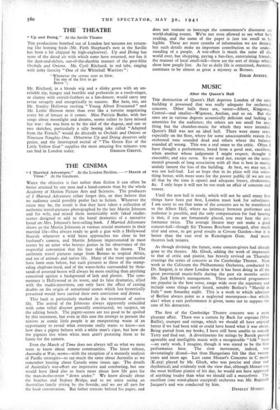THE CINEMA
" Married Adventure." At the London Pavilion.—" March of Time." At the Gaumont.
WHEN the objective is fact rather than fiction it can often be better attained by one man and a hand-camera than by the whole Academy of Motion Picture Arts and Sciences. The producers of I Married Adventure either forgot this, or they believe that no audience could possibly prefer fact to fiction. Whatever the cause may be, the result is that they have taken a collection of authentic travel-pictures photographed by the late Martin Johnson and his wife, and mixed them inextricably with faked studio- scenes designed to add to the banal dramatics of a narrative based on Mrs. Johnson's best-selling book. I Married Adventure shows us the Martin Johnsons at various crucial moments in their married life—Osa always ready to grab a gun with a Hollywood flourish whenever a wild beast approaches too close to her husband's camera, and Martin Johnson impersonated in most scenes by an actor who betrays genius in his observance of the respectful convention that his face shall not be shown. The authentic travel pictures range from Borneo to tropical Africa, and are of animal- and native life. Many of the most spectacular have been seen before, but such pictures as those of the stamp- eding elephant-herd, and of the water-holes surrounded by thou- sands of assorted beasts will always be more exciting than anything conceived against a background of lath and plaster. The com- mentary is Hollywood at its worst, and its false dramatics, allied with the studio-insertions, can only have the effect of casting doubts on the origin of sensational scenes which less hysterically presented would have carried their own conviction and drama. This fault is particularly marked in the treatment of native life. The arrival of the Johnsons always apparently coincided with some tribal disaster generally constructed, we suspect, on the editing bench. The pigmy-scenes are too good to be spoiled by this treatment, but even in this case the attempt to present the natives as comic little people is an exasperating waste of an opportunity to reveal what everyone really wants to know—not how does a pigmy behave with a white man's cigar, but how do the pigmies live when white men aren't pestering them to be funny for the camera.
Even the March of Time does not always tell us what we most want to know about remote communities. The latest release, Australia at War, seems—with the exception of a masterly analysis of Pacific strategies—to say much the same about Australia as we remember hearing about Canada some issues ago. The details of Australia's war-effort are impressive and comforting, but one would have liked also to learn more about how life goes for the man-in-the-street " down under." We know already about the beaches and Sydney Bridge, and so we enjoy seeing an Australian family sitting by the fireside, and we are all ears for the local conversation. But father retreats behind his paper, and
does not venture to interrupt the commentator's discourse on world-shaking events. We're not even allowed to see what he's reading, and the name of the paper is just too small to be legible. These are mere crumbs of information we are denied, but such details make an important contribution to the under- standing of a people. A war-effort is much thg same all the world over, but shopping, paying a bus-fare, entertaining friends, the manner of local small-talk—these are the sort of things which show how people live. As far as daily life is concerned, Australia continues to be almost as great a mystery as Borneo.
EDGAR ANSTEY.






























 Previous page
Previous page